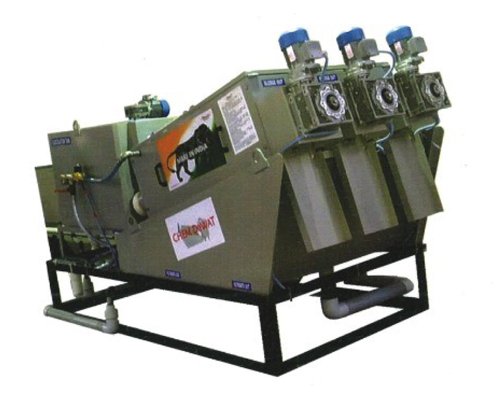The Screw Press is a state-of-the-art thickening and dewatering system designed to optimize sludge management. It serves as an effective alternative to traditional equipment such as Centrifuge Decanters, Filter Presses, and Belt Presses, offering enhanced efficiency and reliability in various industrial applications.
The working principle of the Screw Press is based on a combination of flocculation and mechanical compaction, ensuring superior performance. The process begins as the sludge enters the feed tank, where it flows past the V-notch. At this stage, a polymer dosing system is employed to induce flocculation, ensuring that the sludge forms larger, more manageable particles.
Once flocculated, the sludge moves into the ring system, where the core operation occurs. Within this system, a combination of moving and stationary rings works to apply consistent pressure, progressively compacting the sludge. This mechanical action effectively separates water from the sludge, creating a solid, cake-like material. At the final stage of the process, the dewatered sludge cake is discharged, ready for further handling or disposal.
The Screw Press offers numerous advantages, including energy efficiency, compact design, and low maintenance requirements, making it a highly sought-after solution in modern wastewater treatment facilities and sludge-handling operations.
- Advantages
- Capable of working 24/7
- Lesser polymer consumption
- Consistent in maintaining moisture content between 70% to 80% for bio sludge & 50% to 60% for chemical sludge
- Very very minimum flush water consumption Application
- Minimum maintenance & operating cost
- Minimum noise level
- Suitable for any sludge
- Application
- Domestic & Municipal STP
- Food & beverages
- Slaughter breeding
- Printing & dyeing
- Chemical
- Oil
- Paper & pulp
- Petrochemical
- Etc.,
- Working Principle
- The sludge transferred at the feed chamber
- There after sludge then through the weir at measured flow enters into to the flocculation zone and then thoroughly mixed with the flocculation aid solution
- The sludge fully mixed by the blender forming bigger floc is travels by gravity to the screw body
- The floc by gravity started to move from the de-watering zone to the concentration zone to get the dewatered sludge with moisture content as specified through the sludge chute.
- The space between movable annular plate and the fixed annular plate in the dewatering part narrower and narrower. Further pressure is exerted by the plate located on the exit of output sludge cake.
- DeWAT Models
- Model
- CDeW 02-05
- CDeW 05-10
- CDeW 10-20
- CDeW 20-30
- CDeW 30-40
- CDeW 40-50
- CDeW 50-70
- CDeW 70-100
- CDeW 100-140
- CDeW 150-210
- CDeW 200-300
- CDeW 300-450
- Screw Motor Power (KW)
- 0.18
- 0.18
- 0.18
- 0.36
- 0.54
- 0.72
- 0.75
- 1.10
- 2.20
- 2.20
- 3.30
- 4.50
- Mixer Motor Power (KW)
- 0.18
- 0.18
- 0.18
- 0.36
- 0.36
- 0.36
- 0.75
- 0.75
- 1.50
- 1.50
- 1.50
- 1.1 +1.1
- Total Power (KW)
- 0.36
- 0.36
- 0.36
- 0.72
- 0.90
- 1.08
- 1.50
- 1.85
- 3.70
- 3.70
- 4.80
- 6.70



